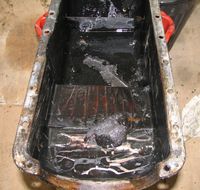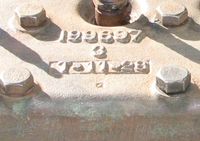-
Posts
271 -
Joined
-
Last visited
Content Type
Forums
Gallery
Events
Posts posted by nvonada
-
-
These are low-compression engines and will run off just about anything. Some old rubber parts do not react well to alcohol so you may want to avoid ethanol. 90/10 ethanol gas also does not age well so don't let it sit forever without using the gas.
I rebuilt the carb on my '41 Champion and replaced the fuel pump and all the rubber hoses. It has been running straight 87 octane 90/10 pump gas for years now. On the other hand I just resurrected a Jeep Jeepster that had been sitting for 30 years and almost immediately had the accelerator pump and a couple of seals fail in the carb. That could have been the ethanol or could just have been age, no way to tell. But it also seems to be running great on regular gas now with a rebuilt carb and new rubber throughout.
-
I have not used them personally but I have heard good things about Moyer's Fuel Tank Renu in Greensburg, PA. Worth calling them and sending them a picture or two.
-
The real experts here will know about your car but some cars had manual advance controls for hand cranking to prevent wrist-breaking backfires.
-
That is one nice-looking car. Well done!
-
Rats, I rooted through my M/C collection and none have the gasket. Sorry!
-
The cap diameter may well be the same. I have some old brake cylinders for my car that may or may not have gaskets. I will measure this weekend. Does this picture look close?
The good news is you can probably use paper or cork gasket material in there or even cut one from any rubber that is safe for brake fluid. It is not like this is a pressure vessel or anything.
-
I like the patina on that paint.
-
That does not look like rust on the valves. Looks like lead deposits to me. And those fiber timing gears seem to fail suddenly and with little warning. The good news is you probably now know why the car was parked.
-
Have you checked with Shrock Brothers?
-
I would not assume your horn button is at fault for the horn problem. You need to trace the horn circuit and isolate the problem. There should be a relay and I would start there. On the oil side I knew my 41 had a lot of sludge so I ran non-detergent until I could drop the pan and clean out the engine. Now I run normal detergent oil. I saw no difference in performance except the multi-grade oil flows better cold so the engine cranks a little easier.
Nathan
-
The only real negative is that if the engine has never been run with detergent oil it can be full of sludge. The detergent oil may dislodge this and cause problems. That said if you don't see chunks of slime dripping out when you drain the oil you are probably OK. I sure used to get some real boogers out of mine. And when I dropped the pan I found this:
-
Studebaker International has rebuild kits for the Champion 6 but I am not sure about the Commander. Worth giving them a call. I had a heat riser bolt snap off and the mounting plate crack. Ended up having a machine shop drill out the broken bolt and re-tap it when I got the manifold sandblasted. I used stainless hardware to put it back together

-
Those are all Carter WE carbs right? The three-digit number is the tag number for a particular carb setup. In which case you can probably get any Carter WE and rebuild with your old carb's parts. There are usually several on e-Bay. But no harm in going right to an expert and getting what you need if you don't want to fight with it.
-
Whups! Wrong forum. I was thinking the SDC forums. Here is a link to the conversation I was thinking about:
http://forum.studebakerdriversclub.com/showthread.php?9397-intake-exhaust-manifold-gasket
I searched on "exhaust manifold gasket leak" and got two pages of hits. So you are not alone...
Pages on my web site about the manifold:
http://stude.vonadatech.com/wp/engine-removal-and-cleanup/engine-manifold-repair/
-
jwb,
There is a lip all around the "arch" of the fender skirt that "hooks" around the curve of the wheel arch. My skirts have some thin rubber (old inner tube maybe?) glued into it. This lip is what holds the skirt in place. The tabs on the bottom just keep it from falling off.
There was just a discussion about exhaust manifold leaks a couple of weeks back. Search the forum and it should turn up. Your Commander 6 is very different from my Champion 6. Hope your manifold is not cracked but I would bet it is not. On my car the nuts and studs were in really bad shape from years of rust and exhaust leaks. But that is all pretty easy to replace.
Nathan
-
I don't have any pictures (skirts are not installed) but my aftermarket skirts just have two tabs (one on each end). Screws went through those tabs into the bottom of the fender.
-
We shall see. Even if I only get 5 it is only about $200/year.
-
For my 41 I ended up going with Coker radials with tubes. So far I am very pleased. They were expensive but I should get at least 10 years from them

http://stude.vonadatech.com/wp/repair-and-upgrades/new-tires/
-
I am pretty sure those drive gears are standard across most (all?) Borg Warner trannies. You might have to change the drive gear inside the transmission to get the ratio you need to work. There are also speedometer shops that can make up a ratio converter box that will get you any ratio you might need. Here is one:
http://www.speedometershop.com/ratio.html
Hopefully someone can chime in who knows more about this than I do.
Nathan
-
After the block is frozen and cracked corrosion will be a non-issue. You only have to forget once.
-
I suppose it would be cheating to use an electric motor to run both the mill AND the Stude engine
 This looks like a very cool project. I really like those post-and-beam buildings.
This looks like a very cool project. I really like those post-and-beam buildings. -
I think I saw a 35 model line brochure on e-bay recently. That would probably have a bunch of good interior pictures.
-
This is really easy to measure. If you don't have a cheap multimeter get one. Set it to DC volts and put one lead on the battery negative terminal and the other on the low-beam terminal of the headlamp socket (I am 90% sure that is the horizontal terminal). Turn the lights on and measure the voltage. That is the voltage drop across the supply for your headlights. Now move the meter to the ground terminal ( if "n" is the terminal i think the ground is the right side of the "n"). Read that voltage and subtract from the battery voltage measured across the battery terminals. That is the voltage drop on the return side. Both should be as low as possible. Grounds tend to be the troublemakers because the supply leads are all tied to nice terminal blocks with brass screws while grounds are just screwed to the nearest metal. Find the problem then fix it. Replacing your wiring harness for a bad ground is like amputating your arm for a paper cut.
"Earth" is British for ground. You see it a lot in the Hayes manuals written there.
Nathan
-
If the engine is original you can get a date from that as well. The head and block both have casting dates. Here is mine:
This is for a 1941 Champion. "T" is 1940 so my head was cast November 28, 1940. The date on my production order is December 12, 1940 which was also stamped on the engine under the manifold flange. If your engine and head were cast in 1939 I would expect an "S" for the year code and the casting date would be some time before the actual build date.
Nathan





What gas tank fits a 1937 Dictator
in Studebaker, Erskine & Rockne
Posted
Your tank is intact and looks pretty solid. I can't imagine getting it professionally restored would not be easier and cheaper than engineering an entire custom fuel tank solution.